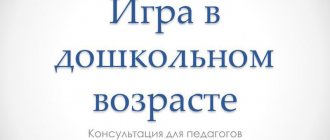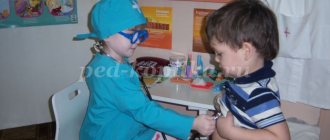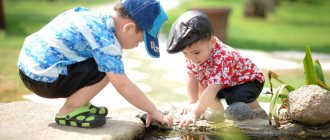Pedagogical supervision of a 3-4 year old child. Type of activity game
Pedagogical supervision of a child 3-4 years old
Pedagogical observation of a child during play activities
Author: Chernikova Natalya Valentinovna, teacher of MBDOU d/s No. 24 of the combined type “Polyanka”, Kstovo, Nizhny Novgorod region Description of the material: the material will be useful to educators, teacher-psychologists, parents for the purpose of observing the game a child of 3-4 years old, involving him in the process of play activities. Such pedagogical observation will help teachers assess the process of child development in the leading activity - play, and plan their further teaching activities. Goal: analysis of the formation of the play activity of a child of primary preschool age. Objectives: to encourage him to accept the task set by the teacher; enrich the content of play activities and the child’s play experience; promote the use of substitute objects, imaginary objects; form positive relationships between a child and an adult. Tools: doll, play corners in the group, toys (substitute items), table, sofa, knife, cutting board. Methods: questions, answers, game situation. Participants: teacher, child. Progress of pedagogical observation: /Dima has a pyramid ring in his hands, he spins it in front of him and moves aimlessly around the group, making one circle after another/
Educator: Dima, what are you doing? Dima: I'm driving. Educator: Do you have a car or a truck? Dima: I have a car. /the child can name the make of the car/ Educator: Where are you going? Dima: To the store. / if the child finds it difficult to answer, the teacher can offer to go to the store. You can come up with any other game situation, for example, going to the post office, to the laundress, to the pharmacy.
Depending on the game situation, the development of the game's plot will depend. /
Educator: What do you want to buy in the store? Dima: I'll buy candy. I love them very much. Teacher: /holds a doll in his hands/ The doll Katya and I also love candy very much. Will you treat us? Dima: Of course, I’ll treat you. /reaches the toy stand, pretends to buy candy, drives back/ Here are some candy for you. /unclenches his fist, puts imaginary candies on the teacher’s palm/ Teacher: /pretends to try the candy, treats the doll and thanks Dima/ Thank you, Dima. Tasty candy. Dima: / rejoices, volunteers to buy something else for the doll and the teacher / Now I’ll go to the store again and buy groceries. Educator: Very good. Katya and I will set the table. Please bring some bread and sausage. Dima: Wait. I quickly. /drives, but gets stuck on the way/ I ran out of gas. Need to refuel. /drives up to the FIZO corner, takes the jump rope, connects it to the car and refuels; then he goes to the store, stops near the shelf with toys, thinks, chooses a brick and a cylinder, and goes back; Another situation may happen, for example, the car may get stuck on the road or break down.
Depending on the current situation, the child’s actions will depend /
Educator: Dima, what happened to you on the way? You were away for a long time. Dima: The car ran out of gas. I stopped at a gas station and filled the car with gasoline. Educator: Did you remember to buy groceries? Dima: Yes, I bought bread and sausage / hands the teacher a brick and a cylinder / Teacher: Well done! Let's have dinner now. /cuts bread and sausage/ Go, wash your hands, sit down at the table. /have dinner/
We recommend watching:
Master class for teachers Role-playing game in the younger group. Daughters - mothers Games for the development of sensory analyzers for children 3-4 years old Collective games for children of the younger group (3-4 years old)
Similar articles:
Educational games for children 3-4 years old in kindergarten
Games to develop communication for preschoolers
Games for the development of speech and thinking for children 3-4 years old in kindergarten in a group
Outdoor games for children 3-4 years old in kindergarten
Summer games for children 3-4 years old in kindergarten
The purpose of observation is to study the nature of the child’s interaction with peers in joint activities.General recommendations for organization.
To implement this observation, the method of experimental situations is used, aimed at the interaction of children with each other (situations may have a conventional name, for example: “Pencils”, “Wheelcar”, “Mosaic”). The teacher organizes situations that initiate children to interact with each other. Based on the occurrence (or absence) of interaction between them, effective, verbal and emotional manifestations are recorded on a rating scale indicating the circumstances. Observation indicators may correspond to the characteristics of children's types of behavior in interaction with each other.
Behavioral manifestations of a child in interaction with a peer (indicators modified, studies by L. N. Galiguzova, S. Yu. Meshcheryakova, E. O. Smirnova were used)
Type of behavior in the interaction of children with each other
| Forms of personal and social behavior of children in interaction with each other | |
| Type "object relation" | A peer is an interesting object; actions are indicative and exploratory in nature, do not contain attempts to make contact, and are not designed to elicit a response |
| Type "object communication" | A peer is like a toy; actions are aimed at studying a peer, his object qualities; unceremonious, insensitive to the reactions of their peers |
| Type “subjective interaction” | Peer as a subject of activity; specific actions, only for contacts with peers; imitation; demonstration of things and possibilities, “infection” with each other’s emotional state, etc. |
For evaluation, criteria with corresponding points are used:
- if this form of behavior did not manifest itself at all - 0 points;
— with a single manifestation — 1 point;
— several times — 2 points;
- if it appears relatively often - 3 points;
- if it is of a dominant nature - 4 points.
Based on observations, the types that characterize the interaction of a child with a peer are determined (the characteristics of the types are based on modified research data by L. N. Galiguzova, S. Yu. Meshcheryakova, E. O. Smirnova): the “object relation” type, the “object communication” type , type “subjective interaction”.
Description of diagnostic situations.
The goal is to study the features of social manifestations in situations of interaction (or lack thereof) of a young child with a peer.
The names of the situations are conditional, for the convenience of recording children’s manifestations.
Situation 1. “Pencils”
Two children are involved in an interaction situation. Depending on the theme of the previous joint activity, children are invited to draw, provided that each child has their own sketchbook sheet for drawing and they draw something the same (the sun, the road for a train, how a mouse runs, etc.), but a glass with pencils one for two.
Situation 2. “Ride-on cars”
Similarly, from two to four children are involved in the interaction situation (regardless of the child’s gender). Children are invited to ride together in cars in the limited space of a group room and transport bricks (construction set) to a certain place to build a tower. Each child has his own car and a sufficient number of bricks.
Situation 3, “Mosaic”
Two or three children are offered the didactic game “Mosaic” (the size of the mosaic figures corresponds to age requirements) with one playing field for all. It is proposed to put together any figures from the mosaic, whoever wants what.
Once the types that emphasize the nature of the child’s interaction with peers have been identified, it is necessary to study the level of social interaction of children in play activities.
Briefly about the main thing
- Observation is a tool that helps parents better understand their child's developmental needs.
- During observation, you should concentrate on the process and not be distracted by thoughts about other matters.
- When observing a child, we need to write down what we see, and not what we think about it.
- After observation, we draw conclusions and change the environment to suit the child’s needs.
Author: Olga Pichurina, head of Montessori and Montessori teacher AMI 0–3
Photo by Olga Goreva
Example of observation and interpretation of results
Child: Nastasya, 1 year 2 months Observation time: from 14:30 to 14:50 Observation location: living room and corridor
14:30 In hand, a soft toy, goes to the rocking horse, sits the soft toy down, it slides off, the baby repeats the action several times.
14:31 She tries to climb onto the rocking chair herself - it doesn’t work, she looks at her mother-observer, demandingly calls for help: “Ah-ah.” When mom doesn’t come up, she goes to her, hugs her, and starts muttering in her own language with notes of indignation.
14:33 He goes into the corridor, picks up the dog’s leash, twirls it in his hands, throws it on the floor, hears the neighbor’s dog barking outside the door, imitates: “Aw-aw.”
14:35 Returns to the room and sees a sheet of stickers on the floor. He picks it up and looks at it, imitating the sounds of the animals in the picture. He tries to peel off one sticker, accidentally tears the sheet, then continues to tear it on purpose.
14:37 He approaches his mother, tries to take away the pen with which mother takes notes, expresses dissatisfaction with sounds when he cannot take it away (mom gets up and walks away). He sits down on the sofa, starts biting his toe and frowns with a dissatisfied face. Throws a pillow from the sofa onto the floor, says: “Boom”, “Pa” (fell).
14:39 Gets off the couch, walks around the room, sees a book, sits down and starts leafing through it. Tries flipping from different sides.
14:40 Hears a dog barking, gets distracted, says “Aw-aw.” He returns to the book and hands it to his mother: “Ahh” (read it). Mom doesn't read - the baby leaves the book. He goes to the chair, takes his sippy cup, starts drinking, then bites the silicone spout. Returns to mom, asks for the breast, eats, then presses our lips to the breast, makes the sound “pr-r” - I like the sound effect, repeats it several times.
14:44 He goes to the dog, starts playing - taking the ball, in the process he imitates laughter: “Khi-khi-khi.”
14:45 He fails to get the ball, moves away from the dog, wanders around the room, repeats: “Prr-r-r”, babbles, tries different sounds, repeats: “Yes-yes-yes.” He approaches the dog’s bowl, begins to throw dry food, one piece at a time, into a cup of water, catches it, looks at it and touches it. Again he throws it into the water, takes it out, puts it in his mouth, spits it out and puts it in the water. He gets to his feet and tries to lift the cup, the water spills. Mom goes to eliminate the flood and stops watching.
Conclusions from observation:
- Imitates and repeats sounds, accompanies his actions and requests with speech → This means that you need to communicate more, read and sing songs, offer classes on onomatopoeia
- Moves a lot: climbs on and off the sofa, masters the rocking horse, bites his toes → We need to provide more opportunities for different movements on playgrounds or install a children's sports complex at home
- Explores different textures by touch and by teeth → Provide access to more objects made from different materials
- Makes “raids” to the dog’s feeding place and performs certain actions there → Try to recreate the same activity at the kitchen table: give the opportunity to apply, shift, taste, mix bran balls with water, fruit puree or pieces of fruit
- Tears stickers → Provide access to soft sheets of paper that can be torn
- Trying to lift a cup of water → Organize games with containers and water in the bathroom
When to start observation and what is its main value?
Observation is important at any age. Children under 3 years of age are just learning to speak, so we cannot get full feedback from them. And after 3 years, children act largely unconsciously - they cannot understand themselves and tell us about their motives and needs.
By observing, we can figure out what is really happening to the child. Why does he cry, what makes him happy and upset. What is interesting for him, what is difficult and what is easy. How he copes with difficulties and finds solutions to new problems. What he is just learning, and what he is ready to do himself.
In Montessori pedagogy, we often talk about observation, because the entire methodology is based on it. With the correct technique of observing a child, we can understand him, see his age-related needs, and most importantly, discern his capabilities.
Mini-course on careful parenting “Without punishment”
Let's learn to set rules and boundaries without shouting and scandals
To learn more





